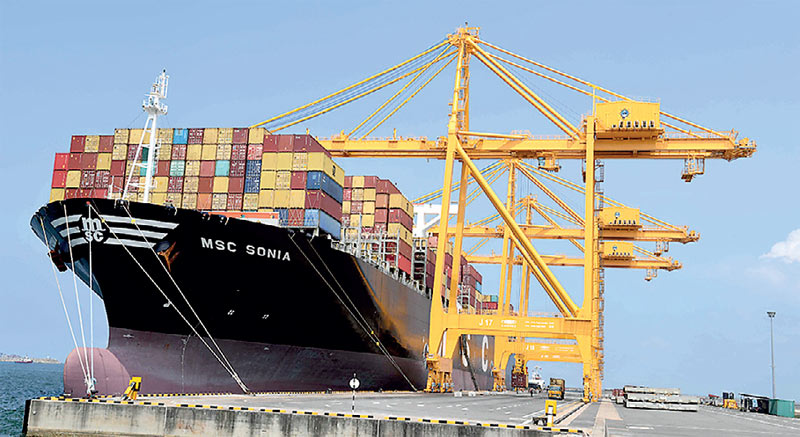Friday Dec 05, 2025
Friday Dec 05, 2025
Friday, 7 January 2022 02:40 - - {{hitsCtrl.values.hits}}

A MSC ship at the Colombo port
After more than two decades at the top of the containership sector, Maersk has finally lost its crown when measured by total capacity operated.
Figures released by Alphaliner show that its 2M alliance partner and closest rival Mediterranean Shipping Co. (MSC) has finally taken the pole position and now operates 4,284,728 TEU, compared to Maersk’s 4,282,840 TEU.
The two lines have been neck-and-neck for the past several weeks, with MSC only now slipping into the top slot by less than 2,000 TEU.
At the start of 2021, the capacity of the MSC fleet stood at 3.8 million TEU. Six months later, it had swelled to over four million TEU with the growth spurt continuing today.
MSC is set to widen the gap too. Its’ order book of over one million TEU far outstrips the 250,000 TEU Maersk has on order and will take MSC’s fleet capacity past the five million-TEU-mark.
It is only in owned tonnage that Maersk will keep its top title, with 2.4 million TEU of capacity held under its own name. MSC’s charter fleet is much bigger and it owns just 1.5 million TEU of its capacity.
Nevertheless, MSC has been on a buying spree this year. By the start of the third quarter, MSC had spent over $ 2 billion on second-hand tonnage amounting to 360,000 TEU, larger than the total fleets of some of its rivals.
Figures from Alphaliner show that during 2021, MSC increased its fleet capacity by 410,877 TEU, or 10.7%. During the same period, Maersk’s capacity rose by just 142,405 TEU, or 3.4%.
Maersk spent much of the 1990s hovering around the top spot. At one point, it overtook Evergreen to become the largest carrier, only to lose pole position when P&O Containers merged with Nedlloyd in 1996. Maersk’s 1999 acquisition of Sea-Land, itself a former No. 1 carrier, pushed it back into the lead, a position it consolidated by acquiring P&O Nedlloyd in 2005.
Unlike Maersk, MSC’s long march to the top slot has not come about through mergers and acquisitions, but through organic growth that has seen it buy and charter more ships rather than buy other companies with their fleets.
While the crossover at the top of the leader table may warrant some celebration in Geneva, where MSC has its headquarters, Maersk is ambivalent about being the largest operator of tonnage.
Chief Executive Søren Skou has consistently said that Maersk’s new strategy as an integrated provider of container logistics is about having the right fleet capacity for its needs rather than the largest fleet. On an analyst call following the company’s third-quarter results, Skou reiterated that Maersk’s capacity would remain at around 4.2 million TEU.
MSC, whose finances remain in the black box of private ownership, has pursued a more aggressive approach, using the earnings it has made in the container shipping boom of the past 18 months to secure capacity, which has been increasingly hard to find. With no shareholders calling for dividends, it is free to invest as much as it wants in fleet expansion.
MSC’s new place at the top of the table is unlikely to mark a major change in either company’s strategy. Maersk is focusing on offering integrate services to its largest customers and is making strategic acquisitions where it sees it can provide benefits for those customers.
“Size isn’t an objective for us,” MSC Chief Executive Søren Toft said.
“At MSC, we never set a specific target to be the biggest. Growth, profitability and supporting customers are what have driven us, and what will continue to drive us forward. We will continue to introduce new services and solutions to support the customer and, consequently, remain competitive.”
MSC, which also runs a large cruise business and has interests in ports and logistics, is also a diversified player, but has focused more on the point-to-point shipping aspect to date. Now, as the largest provider of container capacity, it is well placed to continue in this role.
MSC is also looking to further diversify into integrated logistics, having made a bid for both Brazil’s Log-In Logistica and Bolloré Africa Logistics.
For Maersk, it marks the end of an era when the box ship was the centre of the business. The move comes 25 years after the launch of its first post-panamax vessel, the 6,418 TEU Regina Maersk (IMO: 9085522), and 15 years after the launch of the 15,550 TEU Emma Maersk (IMO: 9321483), the ship that kicked off the era of the ultra-large containership, where Maersk once dominated.
Now, however, Maersk’s 18,270 TEU Triple-E class ships are dwarfed by MSC’s 24,000 TEU behemoths and Maersk has been investing in information technology as much as ships.
The change at the top will make for an interesting historical artefact, but for the world’s two largest box lines it will be business as usual.